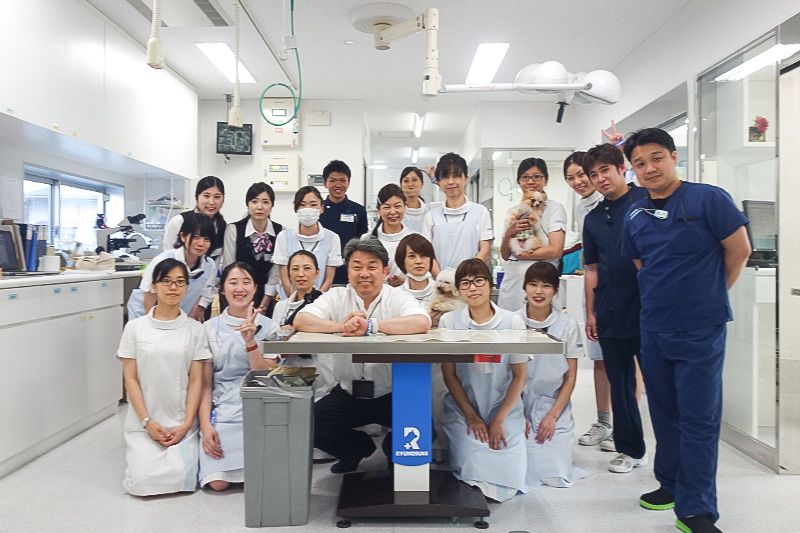
Veterinarian Tokuda Ryūnosuke: Postdisaster Help for Pets and Owners Alike
Society- English
- 日本語
- 简体字
- 繁體字
- Français
- Español
- العربية
- Русский
Tokuda Ryūnosuke, operator of an animal hospital in the city of Kumamoto, opened an evacuation shelter for pets and their owners when the Kumamoto Earthquakes struck in April 2016. Convinced that helping pets helps their owners too, he took to social media immediately after the quakes to inform the public about his shelter and eventually provided care for a total of 1,500 people and 1,000 pets.
Lessons Learned from the 2011 Tōhoku Earthquake
INTERVIEWER What motivated you to open a shelter for owners and their pets?
TOKUDA RYŪNOSUKE When I went to Tōhoku six months after the March 2011 earthquake, I learned that there were no shelters to accommodate pets and owners together. Many owners view their pets as family members, but shelters did not realize the need for keeping pets and owners together and I decided to do something about that. My hospital operates twenty-four hours a day year-round, and when I was planning to rebuild my hospital I hit on the idea of providing an evacuation shelter for owners and their pets in case of a disaster. Learning from the lessons of the Tōhoku disaster, in 2013 I rebuilt my hospital as an earthquake-resistant structure with its own power generator and water tank and decided to use the professional animal care school attached to the hospital as a space to shelter pets and owners if the need arose.
INTERVIEWER When the Kumamoto Earthquakes struck in April 2016, you immediately went online to offer your facility as a shelter for pets and owners.
TOKUDA That’s right. I posted a message two hours after the main shock on April 16. Many pet owners, afraid of causing trouble at regular shelters, came with their pets. I operated the shelter for one month after the disaster, helped by Kyūshū Animal Academy students. During that time we accommodated a total of 1,500 people and 1,000 pets. I was so glad to have thought of providing space for a shelter, giving pets and their owners a place to go. The earthquakes clearly demonstrated the need for owner and pet shelters—something I want everyone in Japan to know.
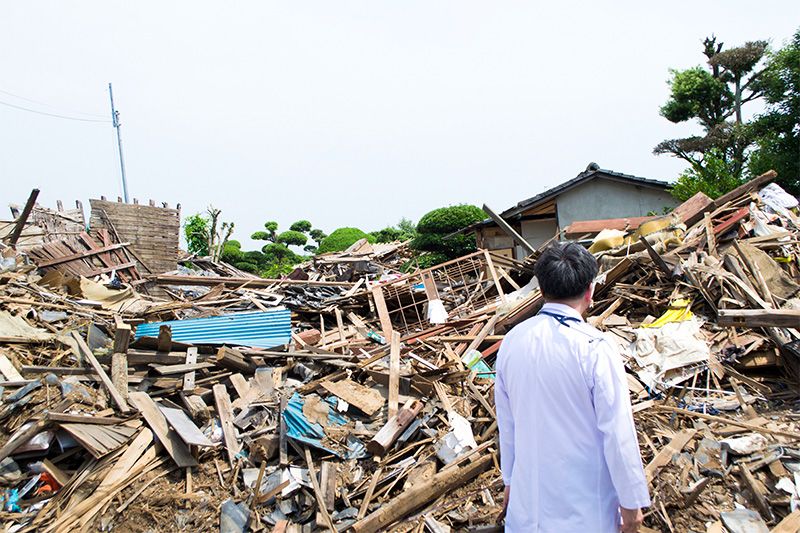 A scene in the town of Mashiki, near Kumamoto. Even when essential services had been restored, many residents had no place to go due to the destruction.
A scene in the town of Mashiki, near Kumamoto. Even when essential services had been restored, many residents had no place to go due to the destruction.
INTERVIEWER Thanks to your efforts, a petition is circulating calling for 25 percent of evacuation shelters to allow pets. How is the petition drive going?
TOKUDA We’ve collected 34,000 signatures so far. In the process of sheltering owners and pets and examining pets at my hospital’s shelter, as well as making house calls in the affected areas, I’ve seen for myself that helping pets also helps their owners. If we are helping humans in a disaster, we need to help their pets too. Saving human lives is the priority, of course, but pets have the power to help heal injured or traumatized people. Ensuring that pets and owners can evacuate together promotes better mental health, since feeling the need to protect a living creature, in this case a pet, gives people a reason to live and improves their mood.
About 20 percent of people in Japan own a pet of some kind, so designating one-quarter of all evacuation as shelters for pets and owners—completely separate from regular shelters, given that some people dislike pets or are allergic to them—seems reasonable. That’s the minimum that we should aim for, given that attitudes toward pets are less evolved in Japan compared to Western countries.
Pets as “Objects” in Japan’s Legal System
INTERVIEWER How do Japanese attitudes toward pets compare to those elsewhere?
TOKUDA Japanese pet owners nowadays view pets as members of the family, but in countries like the United States, Britain, or Australia, pets are viewed even more broadly as members of society. In Japan, legally speaking, pets are considered objects: if an animal is hit or run over by a car, the accident is considered property damage. Pets’ lives are not viewed as precious. When pets and their owners travel by air in Japan, pets go in the cargo hold; in the West, on the other hand, they often travel in the passenger cabin together with their owners. That said, however, things in Japan are slowly changing. In the summer of 2015, torrential rains caused disastrous flooding along the Kinugawa in the northern Kantō region. People climbed onto their roofs with their pets, waiting for help, and both pets and owners were winched up by helicopters to safety. Legally speaking, pets are considered personal property and under current rules would normally have been left behind, but on that occasion they were rescued, which was a big step forward for Japan.
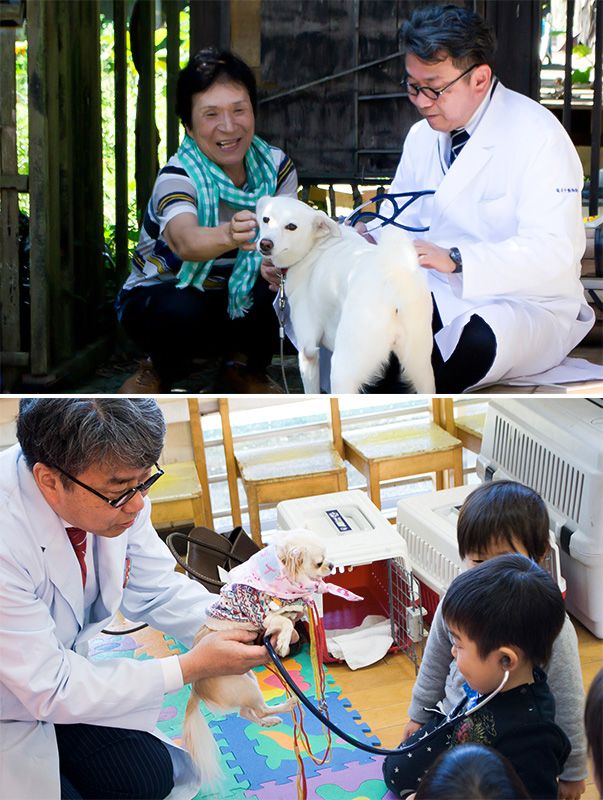 Making a house call to examine a “patient” in temporary housing in Mashiki (top) and visiting a local day-care center as part of postquake mental health care activities.
Making a house call to examine a “patient” in temporary housing in Mashiki (top) and visiting a local day-care center as part of postquake mental health care activities.
Working to Eradicate Rabies in Bali
INTERVIEWER How did you get involved with the rabies eradication program in Bali?
TOKUDA When Kumamoto Prefecture and the provincial government of Bali signed a memorandum of understanding in 2017, Bali’s governor visited my hospital and asked for my help in eliminating rabies in Bali. Rabies is widespread there, and there’s little public understanding of the rabies vaccine or the need to vaccinate dogs. Japan, like Bali, is surrounded by oceans but is rabies-free, because it took the necessary steps and succeeded in eradicating the disease. Bali is an island, so it shouldn’t be difficult to take proper measures and prevent rabies from entering. If dogs are vaccinated and sterilized at the same time, rabies can be stopped. In Bali, the job is to educate people to have their dogs vaccinated and neutered, but the issue must be highlighted so that the public will at least start showing interest.
INTERVIEWER Tell us about the wristbands you created to draw attention to the rabies problem.
TOKUDA I wanted to do something to raise awareness of the Bali rabies eradication drive and raise funds for the project, so I created the wristbands. They’re bright blue with “Eradication of Rabies” printed in white. We sold 3,000 of them at 300 yen apiece. They’ve helped us to raise awareness of the situation in Bali among people who want to help animals, and the people buying and wearing them are helping to educate others. I’m convinced that getting a movement going in Japan will motivate people in Bali to act. I also want to let the world know that a Japanese veterinarian is working on the rabies problem there. We eradicated the disease in Japan, and I’m sure Bali can do the same.
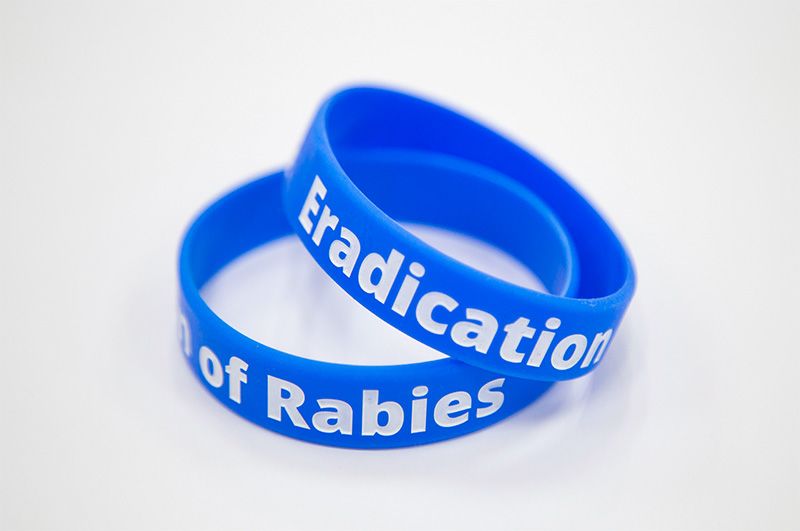 The Bali rabies eradication campaign wristbands.
The Bali rabies eradication campaign wristbands.
Humane Approaches to the Stray Cat Problem
INTERVIEWER In addition to the rabies eradication campaign, you’re also involved in TNR.
TOKUDA TNR is the abbreviation for “trap, neuter, and return.” Today this is an international byword: to prevent stray cats from endlessly multiplying, they are captured, neutered, and then returned to their usual territory. Stray cats are a public nuisance—their urine and feces are smelly, they ransack kitchen waste put out for collection, and they climb onto cars and scooters, scratching or soiling them. TNR can help keep the number of stray cats down. I’m active in the TNR movement, and anyone catching a local stray can bring it to my hospital. I neuter the animal, and after monitoring it for a few days to make sure it’s recovered well, return it to where it came from. At first, some people who disliked cats or were indifferent to them grudgingly participated in TNR, but it was interesting to see how after a while many of them came to feel that the practice was worthwhile. They even developed a liking for cats. TNR also helps create and reinforce community bonds and revitalize neighborhoods. I really feel that animals can help change communities.
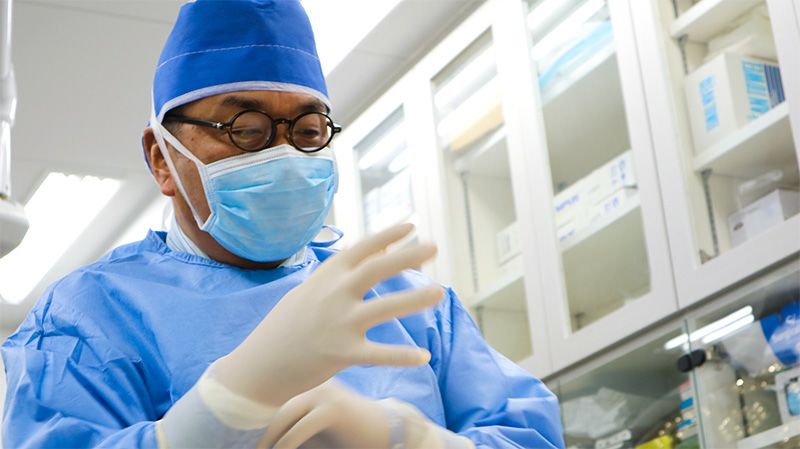 TNR surgeries are an important part of Tokuda’s work.
TNR surgeries are an important part of Tokuda’s work.
INTERVIEWER What are your plans for the future?
TOKUDA I want to educate the public to place more value on pets’ lives. At the Kyūshū Animal Academy attached to my hospital, students are taught that animals are members of society and have equal status with humans. I want to improve quality of life for humans and animals alike. This is something to pursue for the animals, which have a desire to live just like us; for people, who share their lives with animals; and for society as a whole, in which animals and people live together. For this to happen, I believe local animal hospitals should be proactive in communicating information about animals. I’m the type of person who puts a lot of energy into whatever I do, so I’ll continue working full steam ahead as long as I’m needed.
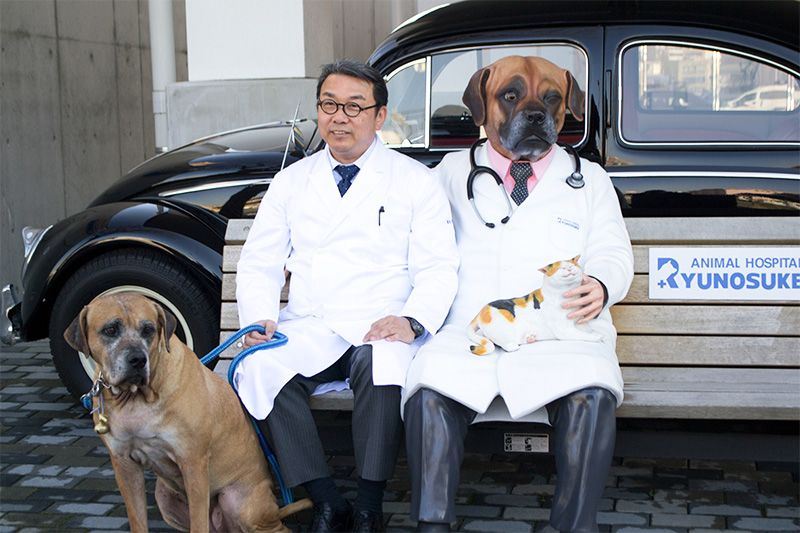 “Dr. Dog” is the eye-catching mascot at the entrance to Ryūnosuke Animal Hospital.
“Dr. Dog” is the eye-catching mascot at the entrance to Ryūnosuke Animal Hospital.

